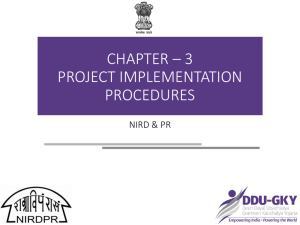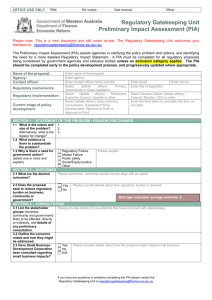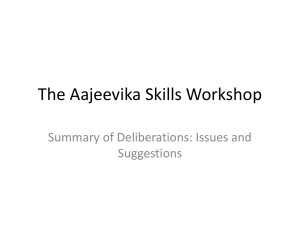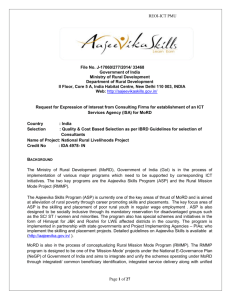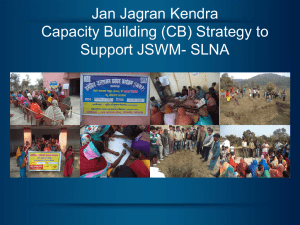Power point presentation of the Chapter 1
advertisement
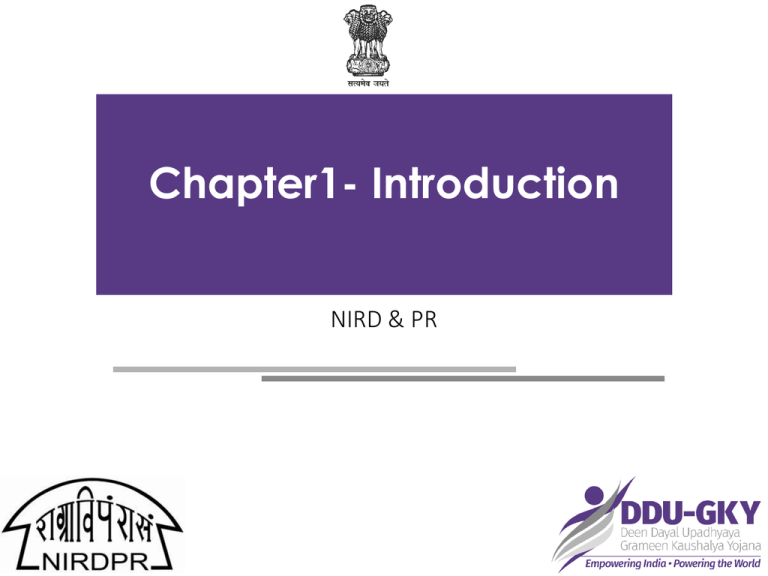
Chapter1- Introduction NIRD & PR Standard Operating Procedures Chapter- 1 Introduction Chapter-3 Project Implementation Procedures Training Chapter 7 – Tracking & Placement Chapter 8 – Project Financial Management Chapter 9 – Grading of a project &Project implementing Agency Chapter-4 Chapter – 5 Chapter- 6 Training Design & Planning Training Centre Training Initiation Outline – Chapter1 Outline of the Manual of SOP Applicability & Changes in Guidelines and SOP Remedy & Action for Delay • Navigation of the Document • Applicability of SOP • Version control • Implementation process • Important events in a project and their timelines • Delay by PIA in NonAAP States • Delay by PIA in AAP States • Delay by CTSA for Non-AAP states/SRLM for AAP States • Procedure to be followed to impose the penalty Roles & ERP • District Administration • Village Level Organization • Gram Panchayat • Approach to quality • ERP Platform and interim arrangement Navigation of Document(1/2) DDU-GKY Project activities are grouped into modules Each module has been assigned a chapter and every item of the module has been detailed in separate sub-sections of the chapter For Eg: 5. Training Center 5.1 Opening of a Training Centre 5.1.1 Look and Feel of a training centre (if 5.1 has three forms they would be SF 5.1A, SF 5.1B SF 5.1 C) Sub-forms under SF5.1A are numbered as SF 5.1A1, SF 5.1A2 SF- STANDARD FORM (located at the end of each chapter as per sequence of appearance in the chapter ) Navigation of Document(2/2) Most sub-sections are divided into two tables. The first table “overview” gives basic understanding of the procedure and second table “Activities” which brings out how the work to be completed. Table1(overview) Item Description Table2 (Activities) Actor Purpose Relevant n Documen completion ts Reference to Guidelines PIA OP Prerequisite/s team Time for completion SRLM Resource/s CTSA Process owner Actio Time for Applicability & Changes in Guidelines and SOP(1/1) Applicability: • SOP applicable to all DDU-GKY and Roshni Projects operational in AAP and Non-AAP states Implementation Process: • PIA have adhere to DDU-GKY guidelines and the standard operating procedures (SOPs) • If PIA is unable able to implement the project, initiate for mutual discussion as per section 4.3(ii) of MoU Version Control: All changes in Guidelines and SOP will be systematically tracked and monitored through a version control system.(SF-1.3A Page No.13) IMPORTANT EVENTS IN A PROJECT AND THEIR TIMELINES(1/2) Phase Code Major Event Indicative time gap between the events I1 Uploading of approved EC minutes 0 day I2 Uploading of Sanction order 15 days after I1 I3 Execution of Memorandum of Understanding (MoU) 20 days after I2 I4 Release of 1st instalment and issue of Project commencement order 10 days after I3 I5 Submission of project execution readiness form After I1 to a maximum of 15 days after I4 Inception phase IMPORTANT EVENTS INA PROJECT AND THEIR TIMELINES(2/2) Phase Cod e Major Event Indicative time gap between the events E1 Commencement of project 30 days after I4. E2 Notification for release of 2nd instalment Release of 2nd instalment Notification for release of 3rd instalment Release of 3rd instalment Completion of training As per prospective work schedule 60 days after E2 As per prospective work schedule 60 days after E4 As per prospective work schedule As per prospective work schedule but not later than 4 months after E6 14 months after E7 E3 E4 Execution E5 phase E 6 E7 Completion of placement E8 Release of 4th instalment and official closure of the project Note: Days, unless explicitly stated differently, refers to working days as defined in MoRD calendar. However, when the reference is in months it would be in calendar months. REMEDY FOR DELAY(1/2) Delay by Notice1 Notice2 Notice 3 By CTSA after 5 days of the first PIA (Non- By CTSA within 5 notice ( if the work is not completed) AAP) days and advise MoRD to take action MoRD waits for 20 days after issue of first notice, if work is not completed, take action for completion of work and invoke conditions for default By SRLM after 5 days of the first PIA (AAP By SRLM within 5 notice ( if the work State) days is not completed) and inform MoRD SRLM waits for 20 days after issue of first notice, if work is not completed, take action for completion of work and invoke conditions for default REMEDY FOR DELAY(2/2) Delay by Notice1 Notice2 Notice 3 MoRD waits for 20 days after issue of first notice, if CTSA for By MoRD giving 5 By MoRD within 5 work is not completed, non AAP days to take further take action for completion days State action in the process of work and invoke for penal action. MoRD waits for 20 days after issue of first notice, If By MoRD giving 5 state does not respond: SRLM for By MoRD within 5 days to take further 1. Regulate the flow of AAP State days action in the process funds 2. AAP status will be reviewed by MoRD Action for Default (1/3) Reasons for Default : a) Shortfall in achievement of target b) Non Compliance c) Fraudulent Practices Concurrent monitoring and advisory system to be put in place through ERP based interactive workflow system. If PIA fails to perform/take remedial action, invoke penal action under default Action for Default (2/3) Classification of Penalties to be imposed: Category Minor Major Penalty (indicative list) Fine up to Rs. 25,000 per occasion Retraining candidates without any additional payment to PIA Closing of training centre/s Reduction of targets Closure of the project Black listing of PIA in the state Black listing of PIA in the country Note: While imposing the penalties a competent authority can impose any of the penalties listed above that penalty. E.g. - While imposing major penalty of closure of the project a fine also can be imposed. Action for Default (3/3) Category Minor Imposing Appellate Authority Authority COO/Skills, SRLM • Head, SRLM • AAP Major Head, SRLM • • Minor Joint Secretary (Skills) Major Joint Secretary • (Skills) Principal Secretary, RD, State Government However for blacklisting across the country approval of MoRD will be required Additional Secretary in charge of Skills at MoRD Non-AAP Additional Secretary in charge of Skills at MoRD Role of District Administration (1/1) Functions of DMMU: a) Mobilization o Facilitating the PIAs during mobilization of candidates o Counseling sessions of parents with the trainers about the benefits of the program. o Identify Potential centers for Job fairs and submit a budget to SRLM to include in Annual Action Plan State/Yearly Plan. ) b) Placement and Tracking o Tracking Details to be uploaded on the designated weblink by DMMU c) Capacity Building for Sub-district functionaries o Periodic workshop to be organized for VLO and BDOs about DDU-GKY Role of Village Level Organization (VLO)/GP (1/1) Identification and developing database of candidates as Per norms of DDU-GKY guidelines. Active participation in counseling and selection of candidates. Tracking of the placed candidates. Feedback from the candidates should be informed to the PIA/DMMU Approach to Quality (1/2) Levels of Monitoring 1. PIA – Operational (OP) Team & Quality (Q) Team 2. SRLM for AAP States /CTSA 3. TSA for Non AAP States /SRLM The primary responsibility of maintaining quality is by PIA. PIA OP team will verify all the records at all the times. The PIA Q team, CTSA & SRLM will verify 100% of some items on a sample basis. The items are listed below: Sampli ng Items 100 % a) Project related records kept at headquarters/regional office, Training centres, Residential centres, b) Course curriculum and contents c) Verification of candidates by PIA OP team, d) PPS payment – documentary evidence like bank transfers etc. Approach to Quality (2/2) Sampling By sample Items a) Candidate documentation b) Assessment of training quality through prescribed methods c) Watching of CCTV modules for various aspects of training quality d) Placement and tracking e) PPS payment – physical verification along with placement and tracking f) Incentive - career progression, one year retention, foreign placement Enterprise Resource Planning Platform and interim arrangements (1/2) ERP Platform, Aajeevika Skills Development and Monitoring System (ASDMS) has been developed. All the standard forms developed in SOP to be used, till the ASDMS gets functional. The formats uploaded in ASDMS would be final. Transition arrangements will be made and instructions on switch over to ASDMS will be given separately. Enterprise Resource Planning Platform and interim arrangements (2/2) THANKYOU
